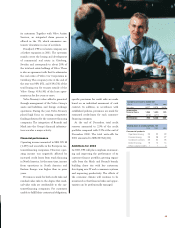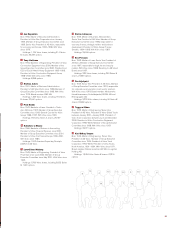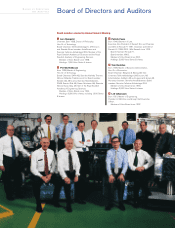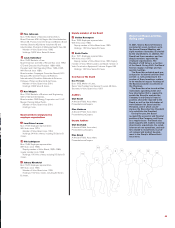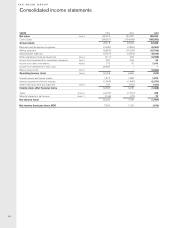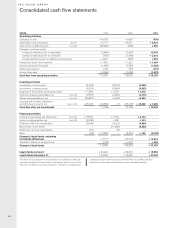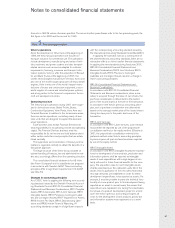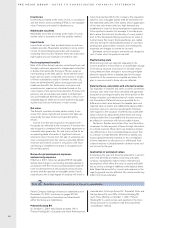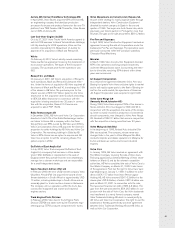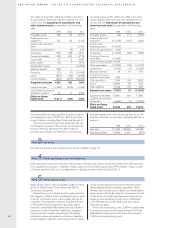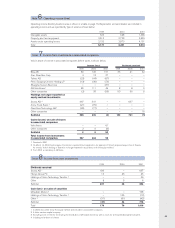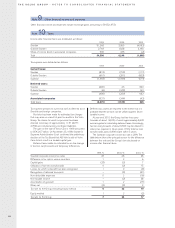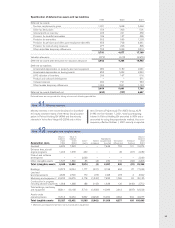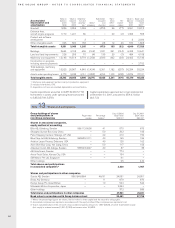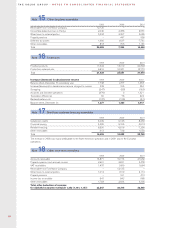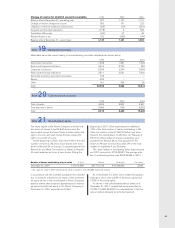Volvo 2001 Annual Report Download - page 63
Download and view the complete annual report
Please find page 63 of the 2001 Volvo annual report below. You can navigate through the pages in the report by either clicking on the pages listed below, or by using the keyword search tool below to find specific information within the annual report.
59
to exchange-rate or interest-rate movements, the purpose
of the loan/instrument is to serve as a hedge and that
the hedging effectively protects the underlying position
against changes in the market rates. Financial instru-
ments used for the purpose of hedging future currency
flows are accounted for as hedges if the currency flows
are considered probable to occur.
Foreign currencies
In preparing the consolidated financial statements, all
items in the income statements of foreign subsidiaries
(except subsidiaries in highly inflationary economies) are
translated to Swedish kronor at the average exchange
rates during the year (average rate). All balance sheet
items except net income are translated at exchange rates
at the respective year-ends (year-end rate). The differ-
ences in consolidated shareholders’ equity arising as a
result of variations between year-end exchange rates are
charged or credited directly to shareholders’ equity and
classified as restricted or unrestricted reserves. The dif-
ference arising in the consolidated balance sheet as
aresult of the translation of net income, in the income
statements, in foreign subsidiaries’ to Swedish kronor at
average rates, and in the balance sheets at year-end
rate, is charged or credited to unrestricted reserves.
Movements in exchange rates change the book value
of foreign associated companies. This difference affects
restricted reserves directly.
When foreign subsidiaries and associated companies
are divested, the accumulated translation difference is
reported as a realized gain/loss and, accordingly, affects
the capital gain.
Financial statements of subsidiaries operating in highly
inflationary economies are translated to Swedish kronor
using the monetary method. Monetary items in the bal-
ance sheet are translated at year-end rates and non-
monetary balance sheet items and corresponding in-
come statement items are translated at rates in effect at
the time of acquisition (historical rates). Other income
statement items are translated at average rates. Translation
differences are credited to, or charged against, income in
the year in which they arise.
In the individual Group companies as well as in the
consolidated accounts, receivables and liabilities in for-
eign currency are valued at year-end exchange rates. In
appropriate cases, hedged receivables and liabilities are
valued at the underlying forward rate.
Gains and losses pertaining to hedges are reported at
the same time as gains and losses of the items hedged.
Received premiums or payments for currency options,
which hedge currency flows in business transactions, are
reported as income/expense during the contract period.
Gains/losses on outstanding currency futures at year-
end, which were entered into to hedge future commer-
cial currency flows, are reported at the same time as the
commercial flow is realized. For other currency futures
that do not fullfil the criteria for hedge accounting a full
market valuation is made on a portfolio basis and are
credited to, or charged against income.
In valuing financial assets and liabilities whose original
currency denomination has been changed as a result of
currency swap contracts, the loan amount is accounted
for translated to Swedish kronor taking into account the
swap contracts.
Exchange differences on loans and other financial
instruments in foreign currency, which are used to hedge
net assets in foreign subsidiaries and associated com-
panies, are offset against translation differences in the
shareholders’ equity of the respective companies.
Exchange gains and losses on payments during the
year and on the valuation of assets and liabilities in foreign
currencies at year-end are credited to, or charged against,
income before taxes and minority interests in the year
they arise. The more important exchange rates employed
are shown above.
Other financial instruments
Interest-rate contracts and foreign exchange contracts are
used to change the underlying financial asset and debt
structure and are reported as hedges against such assets
and debts.
Interest-rate contracts used as part of the management
of the Group’s short-term investments are valued together
with these investments in accordance with the portfolio
method. Provisions are made for unrealized losses in
excess of the unrealized gains within the portfolio.
Interest-rate contracts that do not fullfil the criteria of
hedge accounting are valued at the balance sheet date at
which time provisions for unrealized losses are made.
Capital expenditures
Capital expenditures include investments in buildings,
machinery and equipment, as well as in intangible assets.
Investments pertaining to assets under operating leases
are not included.
Investments in fixed assets included in the Group’s
cash flow statement include only capital expenditures that
have reduced the Group’s liquid funds during the year.
Depreciation, amortization and impairments
of tangible and intangible non-current assets
Depreciation is based on the historical cost of the
assets, adjusted in appropriate cases by write-downs,
and estimated useful lives. Capitalized type-specific tools
are generally depreciated over 2 to 8 years. The depreci-
ation period for assets under operating leases is normal-
ly 3 to 5 years. Machinery is generally depreciated over 5
to 20 years, and buildings over 25 to 50 years, while the
greater part of land improvements are depreciated over
20 years. In connection with its participation in aircraft
engine projects with other companies, Volvo Aero in cer-
tain cases pays an entrance fee. These entrance fees
are capitalized and depreciated over 5 to 10 years.
The difference between depreciation noted above and
depreciation allowable for tax purposes is reported by the
parent company and in the individual Group companies
as accumulated accelerated depreciation, which is in-
cluded in untaxed reserves. Consolidated reporting of
these items is described below under the heading
Deferred taxes, allocations and untaxed reserves.
Goodwill is included in intangible assets and amor-
tized over its estimated useful life. The amortization
period is 5 to 20 years. The goodwill pertaining to Renault
V.I., Mack Trucks, Volvo Construction Equipment, Champion
Road Machinery, Volvo Aero Services, Prévost, Nova BUS,
Volvo Bus de Mexico, Volvo Construction Equipment
Korea and Volvo Aero Norge are being amortized over
20 years due to the holdings’ long-term and strategic
importance.
If, at a balance sheet date, there is any indication that
a tangible or intangible non-current asset has been im-
paired, the recoverable amount of the asset is estimated.
If the recoverable amount is less than the carrying
amount, an impairment loss is recognized and the carry-
ing amount of the asset is reduced to the recoverable
amount.


